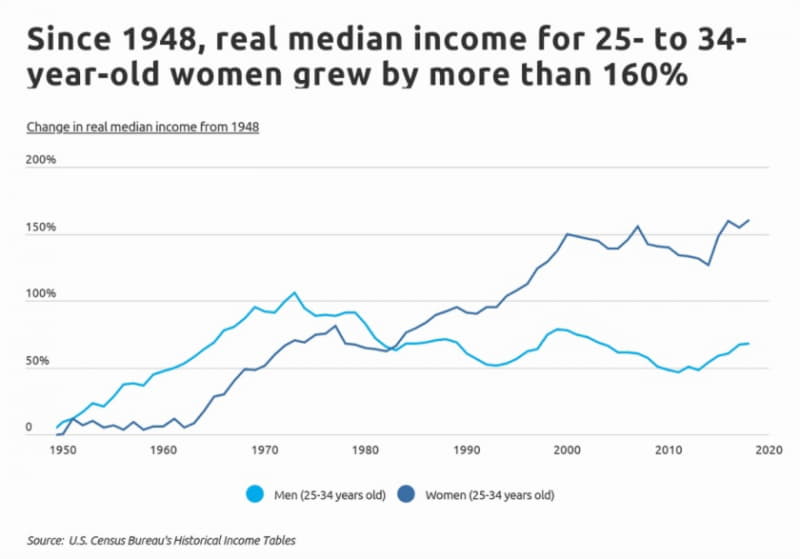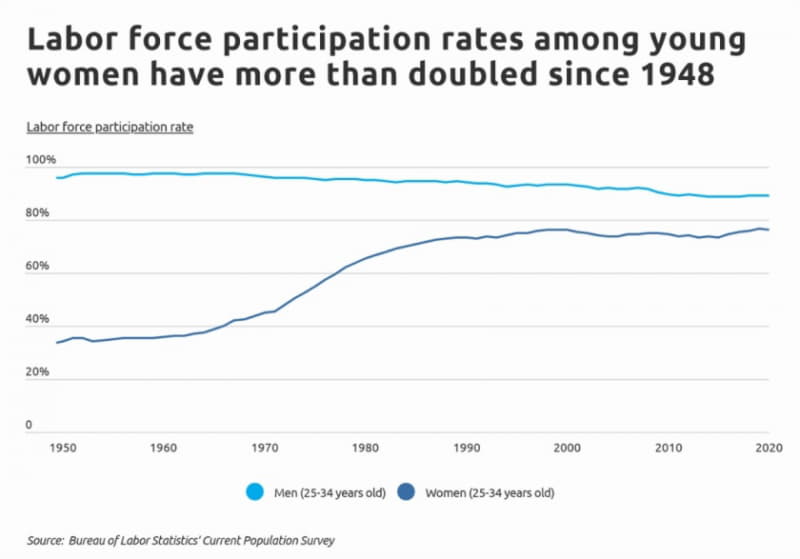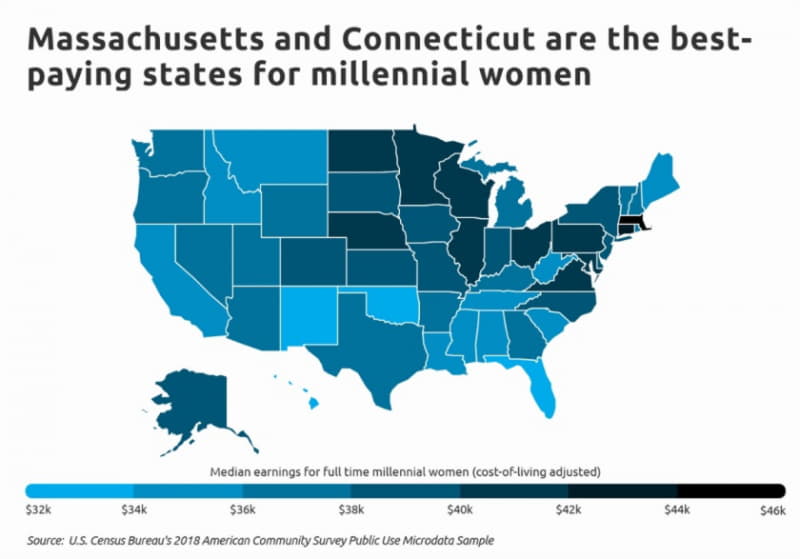Compared to previous generations, millennial women have made tremendous strides in the workforce. Millennial women outpace men when it comes to earning college degrees, they have achieved record-high levels of labor force participation, and they continue to narrow the gender wage gap. According to the latest data from the U.S. Census Bureau, median earnings for full-time millennial women is $38,000 compared to $43,000 for millennial men.
Young women’s median income has risen dramatically over the past 70 years. According to figures from the Current Population Survey, the median income for full- and part-time women aged 25 to 34 was just over $12,000 in 1948 (in 2018 dollars). As of 2018, that figure had increased by 161 percent, to over $32,000. In comparison, real median income for men aged 25 to 34 increased by just 23 percent over the same time period. While young women’s income has grown steadily since 1948 (after adjusting for inflation), that for young men peaked in 1973 and has been trending downward since.

Not only are millennial women earning more today than previous generations, but they are more likely to participate in the labor force. Data from the Bureau of Labor Statistics shows that over three-quarters of women aged 25 to 34 were in the labor force at the start of 2020. This represents a dramatic increase from earlier generations. For reference, just one-third of 25- to 34-year-old women were in the labor force in 1948. Interestingly, labor force participation among young men has declined from its peak in the 1950s. As of the start of 2020, approximately 89 percent of men aged 25 to 34 were in the labor force, down from a high of almost 98 percent in 1955.

Despite strides at the national level, millennial women’s earnings vary considerably across cities and states. In order to make earnings comparable across locations, median earnings for each state and metro were adjusted up or down based on cost-of-living differences. In high-priced cities, such as San Jose, cost-of-living-adjusted earnings are lower than actuals; whereas, in more affordable cities, like Cincinnati, cost-of-living-adjusted earnings are higher than actuals.
At the state level, Massachusetts and Connecticut are the best-paying cities for full-time millennial women, with cost-of-living-adjusted median earnings of $45,579 and $42,413, respectively. At the other end of the spectrum, Florida and New Mexico rank the lowest, with cost-of-living-adjusted median earnings at $33,797 and $32,931, respectively.

To find the best-paying states for millennial women, researchers at Self Financial, a company that helps consumers build credit, analyzed the latest data from the U.S. Census Bureau and the Bureau of Economic Analysis. The researchers ranked states according to the cost-of-living-adjusted median earnings for full-time millennial women. Researchers also calculated unadjusted median annual earnings for millennial women and men and the labor force participation rate among millennial women.
The analysis found that in North Carolina, millennial women earn a cost-of-living-adjusted median annual wage of $38,126. Here is a summary of the data for North Carolina:
- Median earnings for full-time millennial women (adjusted): $38,126
- Median earnings for full-time millennial women (unadjusted): $35,000
- Median earnings for full-time millennial men (unadjusted): $38,800
- Labor force participation among millennial women: 78.2%
- Cost of living: 8.2% below average
For reference, here are the statistics for the entire United States:
- Median earnings for full-time millennial women (adjusted): $38,000
- Median earnings for full-time millennial women (unadjusted): $38,000
- Median earnings for full-time millennial men (unadjusted): $43,000
- Labor force participation among millennial women: 78.6%
- Cost of living: N/A
For more information, a detailed methodology, and complete results, you can find the original report on Self Financial’s website: https://www.self.inc/blog/best-paying-cities-millennial-women






